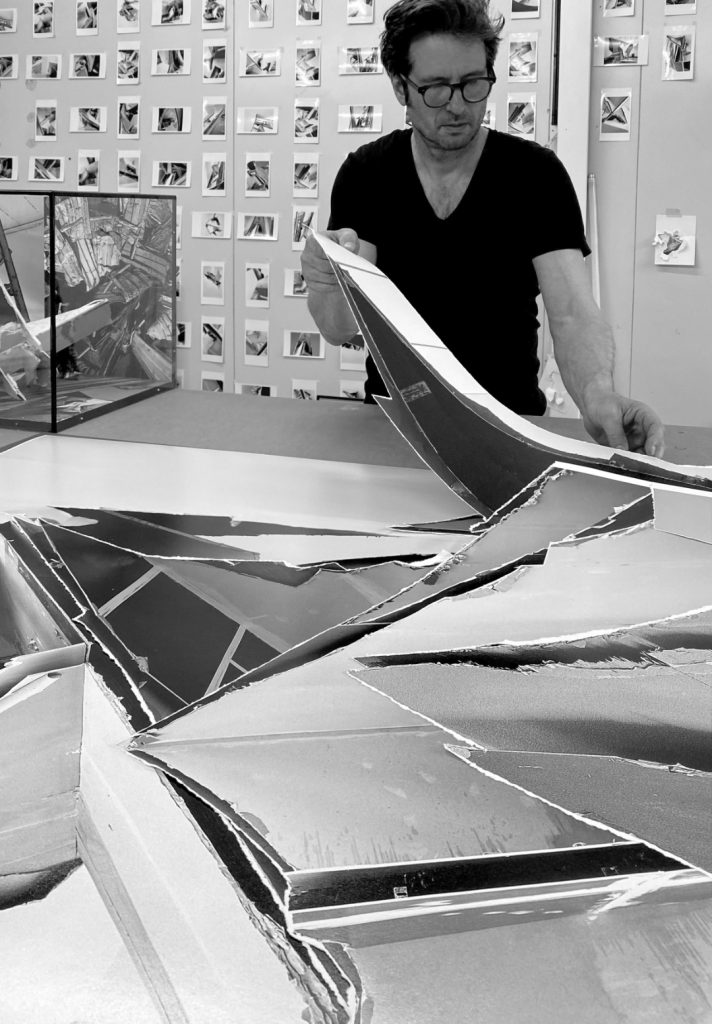
The exploration of space and the body has led to various approaches in the sculptural work of Felix Schramm.
In order to generate his spatial forms, he utilizes diverse media such as spatial installations, sculptures, and collages. His multifaceted practice incorporates classical materials, industrially manufactured substances, as well as waste and dust. Deformations, cracks, or fractures repeatedly disrupt his constructed form ensembles, thereby undermining established orders. This results in new spatial relationships and temporal intertwinings. A critical aspect is how material and form are placed in a precarious relationship. For Schramm, this decomposition is an integral part of creating a new composition.
Felix Schramm’s oeuvre can be categorized into four series: Accumulation, Spatial Intersection, Multilayer, and Dark Site.
Photographs of previously realized spatial interventions form the starting point for two- dimensional Multilayers. The photographs are torn and layered, losing their documentary character and creating new independent pictorial spaces, which, in turn, transform into spatial constructions. This process generates new form relationships, heterogeneous spatial arrangements, and perspectives that destabilize conventional perceptions of space. Through the layering of photographs, a Multilayer emerges, serving as a new spatial cartography.
The Torn Inkjet Prints on baryta paper— already possessing their own structure and spatial unity—are layered, and the upper layer is ripped to rapidly create a new pictorial space. This results in more complex configurations and multiperspectival representations.
A Spatial Intersection is a construction that simultaneously involves tearing down and building up, implying a deconstruction that leads to the creation of a new work. Elements are broken, and the fragments are reassembled in a new arrangement. Old materials are mixed with new ones. In the sculptural process, preexisting spatial contexts are destroyed and recomposed. Without disruption, there can be no reordering of things. Deconstruction and reconstruction not only coexist but merge within the Spatial Intersection, forming a new polyspatial and polytemporal entity.
Usually large-scale, these Spatial Intersections are made of building materials like plasterboard, wood, and paint, resembling remnants of a catastrophe or a collapse scenario at first glance. These sculptures counter the pristine state of the white cube and generate their own spatial presence.
In collections, Spatial Intersections can be permanent installations or temporary setups that are later dismantled and stored.
The Dark Site series consists of material paintings using dust, debris, and silver leaf as creative base substances for monochromatic images. Residues and dust from the artist’s studio or work and installation sites are layered onto a base plate. This impure material is then coated with silver leaf, forming a crust over the waste. As the silver is rigid and brittle, it cracks in many places, revealing the dirt underneath. Dark Site juxtaposes worthless debris with precious silver, elevating the waste and diminishing the value of the noble metal. The works’ uniform dark tone results from the flat, polished, gray-tinted acrylic glass cases, which seal the piece and evoke new fields of association for the viewer.
Accumulation refers to an assemblage of forms created through various sculptural techniques. Maquettes, material samples, color tests, photographs, and sculptural fragments exist within a spatial system called Accumulator. This produces “neighborhoods,” such as between an amorphous casting and a plasterboard model, often originating from different scales and thereby creating dimensional shifts. Objects that have never before shared a direct spatial relationship suddenly confront each other in glass cases, forming a new space. Within the Accumulator, all forms developed in Schramm’s studio serve as tools for a self-referential system that investigates and questions the sculptural process.
TEXT
Felix Schramm in conversation with Stephan Berg
in exibition catalogue Felix Schramm: Intersection, Verlag für Moderne Kunst, Nürnberg
2012
Christina Irrgang: Notes on the work of Felix Schramm
in exibition catalogue: Felix Schramm: Intersection, Verlag für Moderne Kunst, Nürnberg
2012
Hans Jürgen Hafner: Accumulation